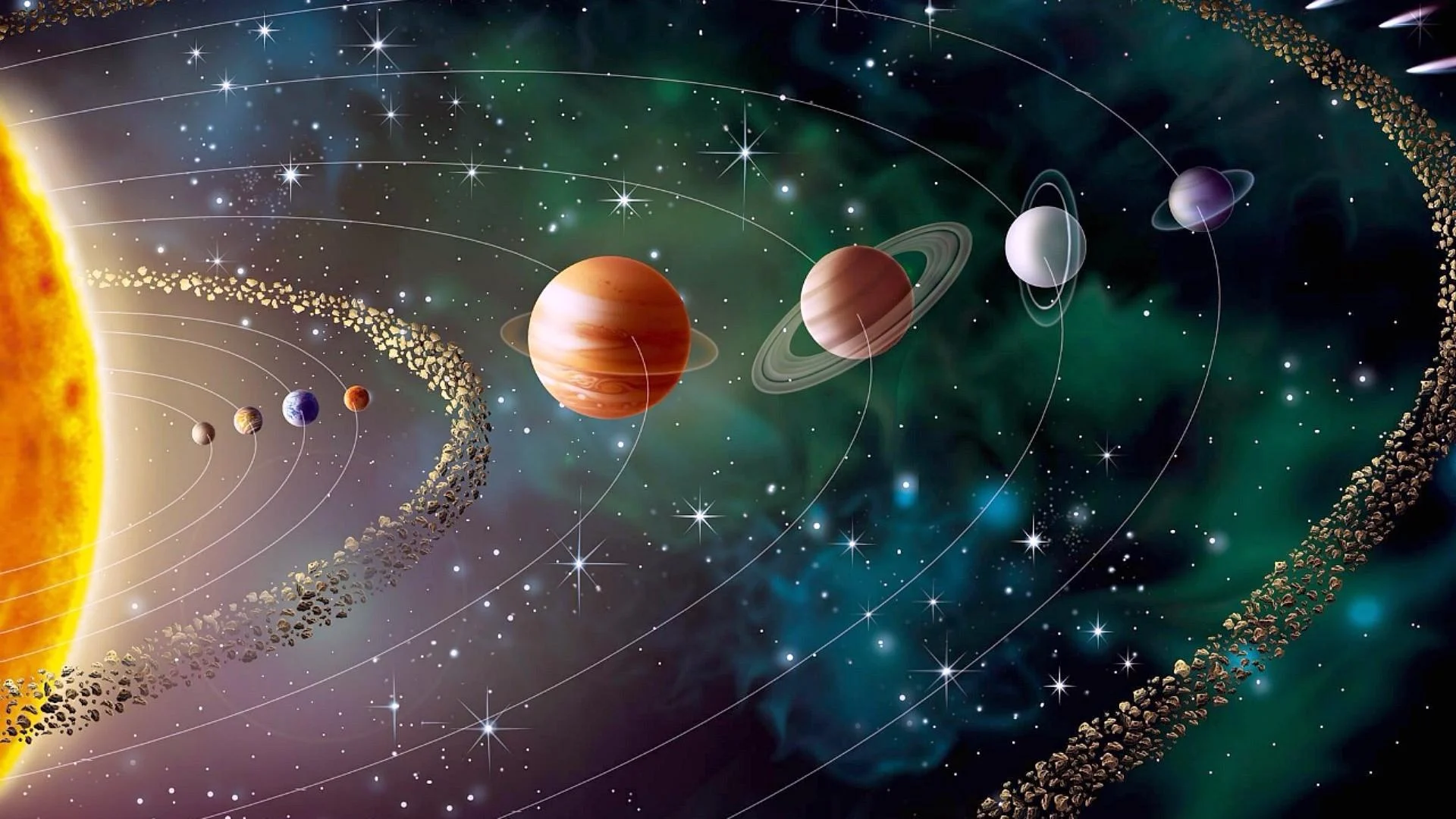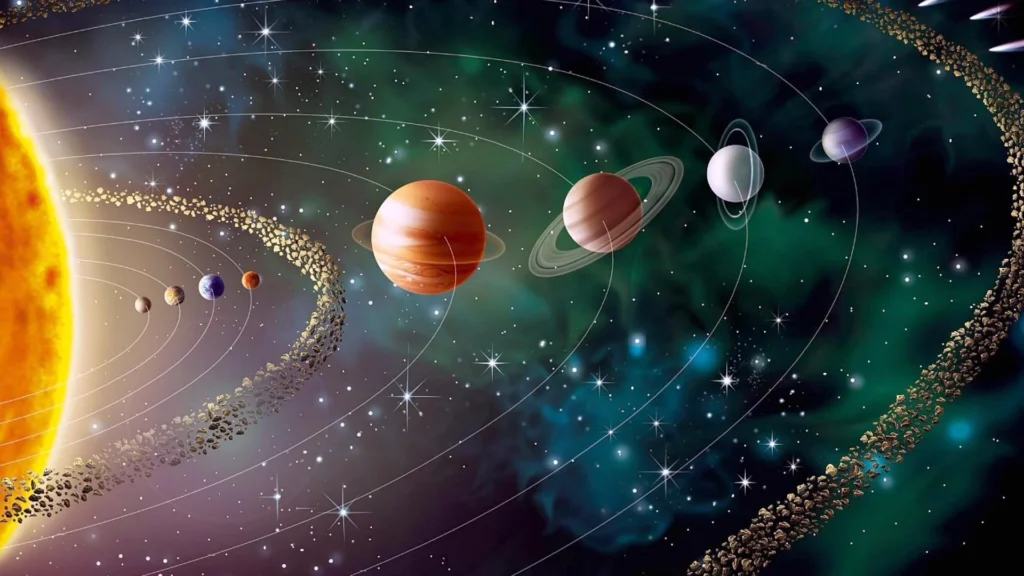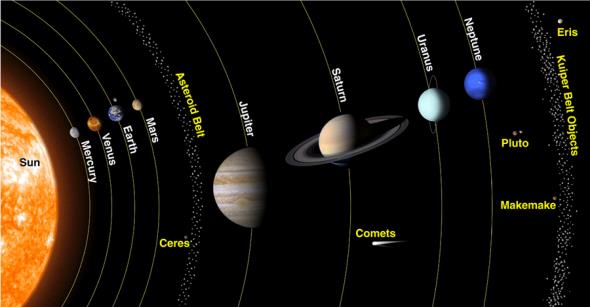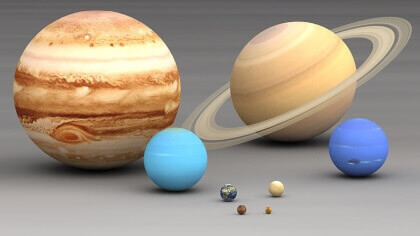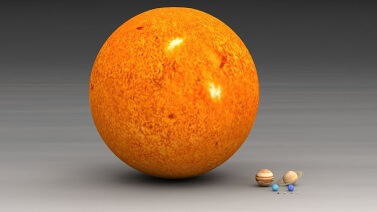
Size comparison of largest moons in the Solar System
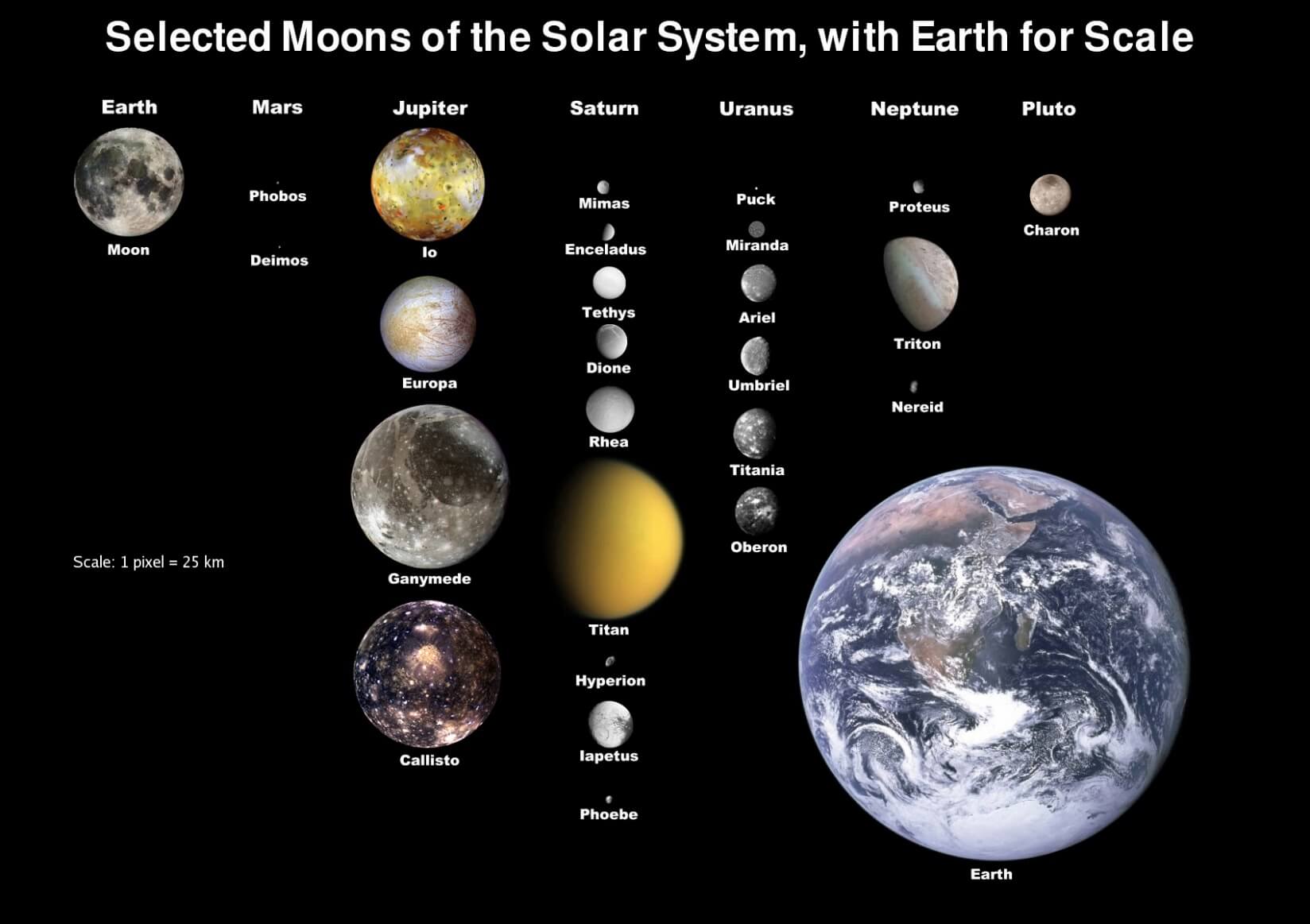
Size comparison of the largest moons with earth
- The inner Solar System is the traditional name for the region comprising the terrestrial planets and asteroids.
- They are composed mainly of silicates and metals.
- The four inner or terrestrial planets have dense, rocky compositions, few or no moons, and no ring systems.
- They are composed largely of refractory minerals, such as the silicates, which form their crusts and mantles, and metals, such as iron and nickel, which form their cores.
- Three of the four inner planets (Venus, Earth and Mars) have atmospheres substantial enough to generate weather; all have impact craters and tectonic surface features, such as rift valleys and volcanoes.
- The term inner planet should not be confused with the inferior planet, which designates those planets that are closer to the Sun than Earth is (i.e. Mercury and Venus).
- The term superior planet designates planets outside Earth’s orbit and thus includes both the outer planets and Mars.
Mercury
- Mercury’s surface appears heavily cratered and is similar in appearance to the Moon’s, indicating that it has been geologically inactive for billions of years (because there is no atmosphere on Mercury).
- When viewed from Earth, the planet can only be seen near the western or eastern horizon during the early evening or early morning.
- It may appear as a bright star-like object but is less bright than Venus.
- Having almost no atmosphere to retain heat, it has surface temperatures that vary diurnally more than on any other planet in the Solar System (−173 °C at night to 427 °C during the day).
- Mercury is smaller than the largest natural satellites in the Solar System, Ganymede (largest moon of Jupiter) and Titan (largest moon of Saturn).
- However, Mercury is massive (has more mass) than Ganymede and Titan.
- Images obtained by MESSENGER spacecraft in 2004 have revealed evidence for pyroclastic flows (vulcanicity) and water ice at Mercury’s poles.
Venus
- Venus is the brightest planet in the solar system and is the third brightest object visible from earth after the sun and the moon.
- It is the brightest among planets because it has the highest albedo due to the highly reflective sulfuric acid that covers its atmosphere. It is sometimes visible to the naked eye in broad daylight.
- Venus is sometimes called Earth’s sister planet or Earth’s twin because of their similar size, mass, proximity to the Sun, bulk composition and presence of similar physical features such as high plateaus, folded mountain belts, numerous volcanoes, etc.
- It is radically different from Earth in other respects. The surface of Venus is totally obscured by a thick atmosphere composed of about 96% carbon dioxide, covered with clouds of highly reflective sulfuric acid.
- It has the densest atmosphere of the four terrestrial planets. The atmospheric pressure at the planet’s surface is 92 times that of Earth, or roughly the pressure found 900 m (3,000 ft) underwater on Earth.
- Venus is by far the hottest planet in the Solar System, even though Mercury is closer to the Sun.
- This is because of the greenhouse effect arising from high concentrations of CO2 and thick atmosphere.
- A day on Venus is equivalent to 243 earth days and lasts longer than its year (224 days).
- It rotates in the opposite direction (clockwise) to most other planets.
- In the ancient literature, Venus was often referred to as the morning star and evening star.
Moon
- Its diameter is only one-quarter that of the earth.
- It is about 3,84,400 km away from us.
- A ray of light from the sun takes about eight minutes to reach the earth. Light takes only a second to reach us from the moon.
- The moon is tidally locked to the earth, meaning that the moon revolves around the earth in about 27 days which is the same time it takes to complete one spin.
- Tidal locking is the name given to the situation when an object’s orbital period matches its rotational period.
- As a result of tidal locking, only one side of the moon is visible to us on the earth.
- The moon is a significant stabiliser of Earth’s orbital axis. Without it, Earth’s tilt could vary as much as 85 degrees (at present the Earth’s axis of rotation is tilted at an angle of 23.5֯ relative to our orbital plane).
- Neil Armstrong was the first, and Buzz Aldrin was the second to step on the surface of the moon on 29 July 1969 (Apollo 11 mission).
- Till date, only Twelve astronauts walked on the Moon’s surface.
Formation of the moon
- It is now generally believed that the formation of the moon, as a satellite of the earth, is an outcome of ‘giant impact’ or what is described as ‘the big splat’.
- A body of the size of one to three times that of mars collided into the earth sometime shortly after the earth was formed. It blasted a large part of the earth into space.
- This portion of blasted material then continued to orbit the earth and eventually formed into the present moon about 4.44 billion years ago.
- Scientists estimate that a day in the life of early Earth was only about 6 hours long.
- The Moon formed much closer to Earth than it is today.
- As Earth rotates, the Moon’s gravity causes the oceans to seem to rise and fall. There is a little bit of friction between the tides and the turning Earth, causing the earth’s rotation to slow down just a little (1.4 milliseconds in 100 years).
- As Earth slows, it lets the Moon move away by a little (four centimetres per year).
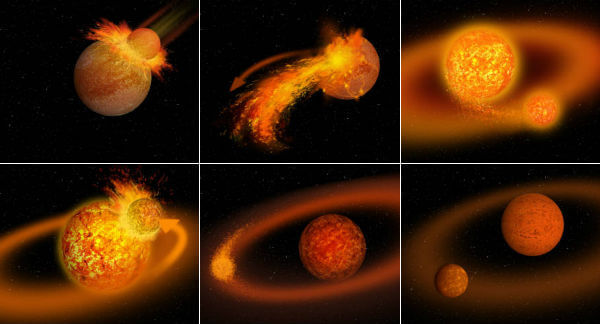
Colonizing the moon
- Discovery of lunar water at the lunar poles by Chandrayaan-1 has renewed interest in the Moon.
- Locations on the Lunar poles avoid the problem of long lunar nights (350+ hours).
- Exploration of the lunar surface by spacecraft began in 1959 with the Soviet Union’s Luna program.
- Luna 2 made a hard landing (impact) into its surface and became the first artificial object on the moon.
- Crewed exploration of the lunar surface began in 1968 when the Apollo 8 spacecraft orbited the Moon.
- The following year, the Apollo 11 Apollo Lunar Module landed two astronauts on the Moon.
- In 2009, the Chandrayaan probe discovered that the lunar soil contains 0.1% water by weight.
Advantages of colonising the moon
- A lunar base could be a site for launching rockets with locally manufactured fuel to distant planets.
There are several disadvantages to the Moon as a colony site
- The long lunar night would impede reliance on solar power.
- The Moon is highly depleted in carbon and volatile elements, such as nitrogen and hydrogen.
- The low gravity on the Moon will have adverse effects on human health in the long term.
- The lack of a substantial atmosphere results in temperature extremes, harmful radiation reaching the surface and increased chances of the colony’s being hit by meteors.
- Growing crops on the Moon is difficult due to the long lunar night, extreme variation in surface temperature, exposure to solar flares, nitrogen-poor soil, and lack of insects for pollination.
Mars
- Mars is often referred to as the “Red Planet” because of the reddish iron oxide prevalent on its surface.
- Mars has a thin atmosphere and has surface features ranging from impact craters of the Moon and the valleys, deserts, and polar ice caps of Earth.
- Mars is the site of Olympus Mons (shield volcano), the largest volcano and the highest known mountain (24 km) in the Solar System, and of Valles Marineris, one of the largest canyons in the Solar System.
- Mars has two irregularly shaped moons, Phobos and Deimos, which are thought to be captured asteroids.
- Liquid water cannot exist on the surface of Mars due to low atmospheric pressure (less than 1% of the Earth’s).
- The two polar ice caps appear to be made largely of water.
- Mars can easily be seen from Earth with the naked eye.
- Mars is less dense than Earth, having about 15% of Earth’s volume and 11% of Earth’s mass.
- Landforms visible on Mars strongly suggest that liquid water has existed on the planet’s surface.
- Mars lost its magnetosphere 4 billion years ago, possibly because of numerous asteroid strikes, so the solar wind interacts directly with the Martian ionosphere, lowering the atmospheric density.
- The atmosphere of Mars consists of about 96% carbon dioxide, 1.93% argon and 1.89% nitrogen along with traces of oxygen and water.
- Methane has been detected in the Martian atmosphere (may indicate the existence of life).
- Methane can exist in the Martian atmosphere for only a limited period before it is destroyed — estimates of its lifetime range from 0.6-4 years.
- Its presence despite this short lifetime indicates that an active source of the gas must be present.
- Geological means such as serpentinization, volcanic activity, cometary impacts, and the presence of methanogenic microbial life forms are among possible sources.
- Of all the planets in the Solar System, the seasons of Mars are the most Earth-like, due to the similar tilts of the two planets’ rotational axes.
- The lack of a magnetosphere and the extremely thin atmosphere of Mars are a challenge: the planet has little heat transfer across its surface, poor insulation against the bombardment of the solar wind.
- Mars is nearly geologically dead; the end of volcanic activity has stopped the recycling of chemicals and minerals between the surface and interior of the planet.
Mars Compared to Earth
- 53% the diameter of Earth.
- 10% the mass of Earth.
- Surface gravity on Mars is only 38% the gravity on Earth.
- A day on Mars lasts 1.03 Earth days.
- Axial tilt on Mars is 25.19 degrees. Very close to Earth’s 23.5֯ tilt.
- A year on Mars lasts about twice as long as an Earth year; the seasons are twice as long.
- The atmosphere of Mars (95% carbon dioxide) is less than 1% the thickness of Earth’s atmosphere.
- Outer Planets are Jupiter, Saturn, Uranus, Neptune and the dwarf planet – Pluto.
- The four outer planets, called the gas giants, collectively make up 99% of the mass known to orbit the Sun.
- They are composed mainly of hydrogen & helium & lack a solid surface. Their moons are, however, solid.
- The two outermost planets, Uranus and Neptune, are composed of substances called ices, such as water, ammonia and methane, and are often referred to separately as “ice giants”.
- All four gas giants have rings, although only Saturn’s ring system is easily observed from Earth.
- The gas giants have a magnetosphere, numerous moons and significant atmospheric activity.
- Neptune has the strongest wind speed (2,100 km/h) followed by Saturn (1,800 km/h).
Jupiter
- It is composed mostly of gas and liquid swirling in complex patterns with no solid surface.
- Jupiter’s four large moons (Io, Europa, Ganymede, and Callisto), called the Galilean satellites because Galileo discovered them.
- Ganymede is the largest natural satellite (5,268 km in diameter) in this solar system and is larger than Mercury, and three times larger than the earth’s Moon (3,474 km in diameter, the fifth largest moon).
- It is the third-brightest natural object in the night sky after the Moon and Venus and the fourth brightest object in the sky after the Sun, the Moon and Venus.
- Because of its rapid rotation (once every 10 hours), the planet’s shape is that of an oblate spheroid (slight bulge at the equator).
- The outer atmosphere is visibly segregated into several bands, resulting in turbulence and storms.
- The latest probe to visit Jupiter is Juno.
Saturn
- Saturn’s rings are probably made up of billions of particles of ice and ice-covered rocks.
- Titan is the second-largest moon in the Solar System (larger than Mercury) and it is the only satellite in the Solar System with a substantial atmosphere (nitrogen-rich).
- In contrast to all other planets, it is tipped and spin on its sides, that is its axis of rotation lies in nearly the plane of its orbit. (The poles of Uranus lie in a plane where equators of other planets lie)
- All eight planets in the Solar System orbit (revolve) the Sun in the direction of the Sun’s rotation, which is counterclockwise when viewed from above the Sun’s north pole.
- Six of the eight planets also rotate about their axis in this same direction (counterclockwise).
- Venus and Uranus have a strange retrograde rotation (clockwise), i.e., opposite of sun’s rotation.
- Uranus and Neptune (the ice giants) are called the twins of the outer solar system.
- They are surrounded by a thick atmosphere of hydrogen and helium and contains a higher proportion of “ices” such as water, ammonia, and methane ice giants” to emphasise this distinction.
- Neptune has the strongest sustained winds (2,100 km/h) of any planet in the Solar System.
Why are the inner planets rocky while the outer planets are mostly in gaseous form?
- The terrestrial planets were formed in the close vicinity of the parent star where it was too warm for gases on the surface to condense to solid particles.
- The solar wind was most intense nearer the sun; so, it blew off lots of gas and dust from the surface of the terrestrial planets.
- The solar winds were not all that intense to cause similar removal of gases from the Jovian planets.
- The terrestrial planets are smaller, and their lower gravity could not hold the escaping gases.
Asteroid belt
- Asteroids are remnants of planetary formation that circle the Sun in a zone lying between Mars and Jupiter. The circular chain of asteroids is called the asteroid belt.
- The remnants of planetary formation failed to coalesce because of the gravitational interference of Jupiter.
- The asteroid belt lies between 2.3 and 3.3 AU from the Sun.
- Asteroids (planetoids ― another term for an asteroid) are composed mainly of refractory rocky and metallic minerals, with some ice.
- Asteroids range in size from hundreds of kilometres across to microscopic.
- All asteroids except the largest, Ceres, are classified as small Solar System bodies.
- Fragments of asteroids break off to form meteoroids, which can reach the Earth’s surface.
Ceres
- Ceres (2.77 AU) is the largest asteroid (946 km in diameter), a protoplanet, and a dwarf planet.
- Ceres has a mass large enough for its own gravity to pull it into a spherical shape.
Pluto and Charon
- Pluto (39 AU) is the largest known object in the Kuiper belt. Charon is Pluto’s largest moon.
- When discovered in 1930, it was considered to be the ninth planet; this changed in 2006 with the adoption of a formal definition of a planet.
- International Astronomical Union’s definition of a Planet: a Planet is an object that:
- orbits the sun;
- has sufficient mass to assume hydrostatic equilibrium ― a nearly round shape;
- is not a satellite (moon) of another object, and
- has removed debris and small objects from the area around its orbit
- IAU’s definition of Dwarf planet: Dwarf planet is an object that meets planetary criteria except that it has not cleared debris from its orbital neighbourhood.
- Pluto is a part of the Kuiper belt that contains millions of rocky and icy objects. Also, there are numerous other objects in the Kuiper belt which are of similar size to Pluto. E.g. Eris (diameter: 2,326 km).
- So, if Pluto is considered a plant, then many other objects like Eris will also have to be considered as planets.
- Hence, Pluto (diameter: 2,377 km) (Kuiper belt) was voted by IAU as a dwarf planet just like Ceres (asteroid belt) and Eris (diameter: 2,326 km) (Kuiper belt).
Kuiper belt
- The Kuiper belt is a great ring of debris similar to the asteroid belt but consisting mainly of objects composed primarily of ice.
- It extends between 30 and 50 AU from the Sun.
- A comet is an icy small Solar System body that, when passing close to the Sun, heats up due to the effects of solar radiation and the solar wind upon the nucleus and begins to outgas, displaying a visible atmosphere or coma, and sometimes also a tail.
- Comets have highly elliptical orbits, unlike the planets which have near-circular orbits.
- They are made of frozen gases (water, ammonia, methane and carbon dioxide) which hold together small pieces of rocky and metallic minerals.
- Short-period comets (orbital period of a few hundred years) originate in the Kuiper belt or its associated scattered disc, which lie beyond the orbit of Neptune.
- Longer period comets, with orbits of thousands of years, come from the more distant Oort Cloud.
- Oort cloud is a giant shell of icy bodies that encircle the solar system occupying space at a distance between 5,000 and 100,000 AU.
- One of the larger comets is the Halley’s Comet. The orbit of Halley’s Comet brings it close to the Earth every 76 years. It last visited in 1986.
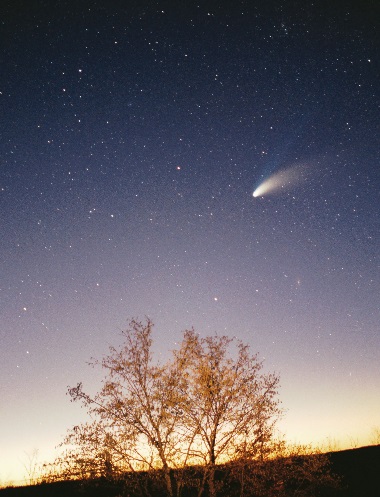
Meteoroid, Meteor and Meteorite
- A meteoroid is any solid debris originating from asteroids, comets or other celestial object and floats through interplanetary space.
- A meteor is the streak of light that appears in the sky when a meteoroid enters the atmosphere (mesosphere) at about 200 km at high speed and burns up because of the friction.
- A meteor is popularly termed a ‘shooting star’ or ‘falling star’.
- In some cases, the meteoroid does not burn up completely and makes its way to the Earth’s surface. The surviving chunk is called a meteorite.
- The circular depression created on the earth’s surface after the meteorite’s impact is called as a meteorite crater.
- Meteorite impacts are common on all planets and moons in the solar system.
- The most conspicuous meteorite craters can be found on the surfaces of the Moon and Mercury (because they are geologically inactive due to negligible atmosphere).
- Largest Meteor Crater: A meteor crater in Arizona (USA) is 1,300 m deep is the largest meteor crater in the world. It was formed over 10,000 years ago.
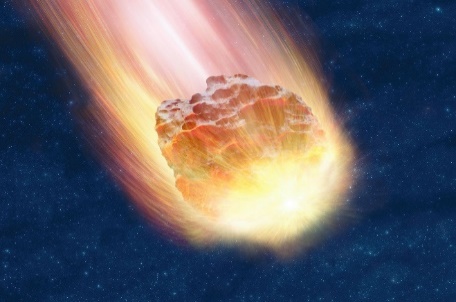
Chicxulub crater
- Chicxulub crater (Mexico’s Yucatan Peninsula) was caused by a meteor impact that is believed to have wiped out the dinosaurs (mass extinction at the end of the Cretaceous 65 million years ago).
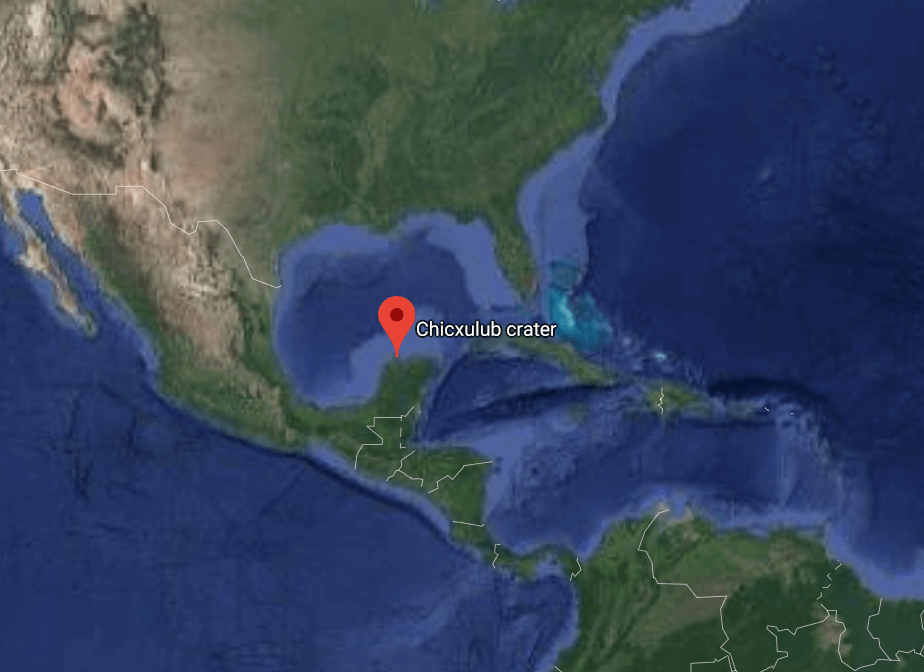
Meteorite craters in India
- Lonar Lake (1.8 km in diameter) in Buldhana District of Maharashtra
- Dhala crater (14 km in diameter) in Shivpuri district, Madhya Pradesh and
- Ramgarh crater (3.5 km in diameter) is a potential meteorite crater in Kota plateau in Rajasthan.

